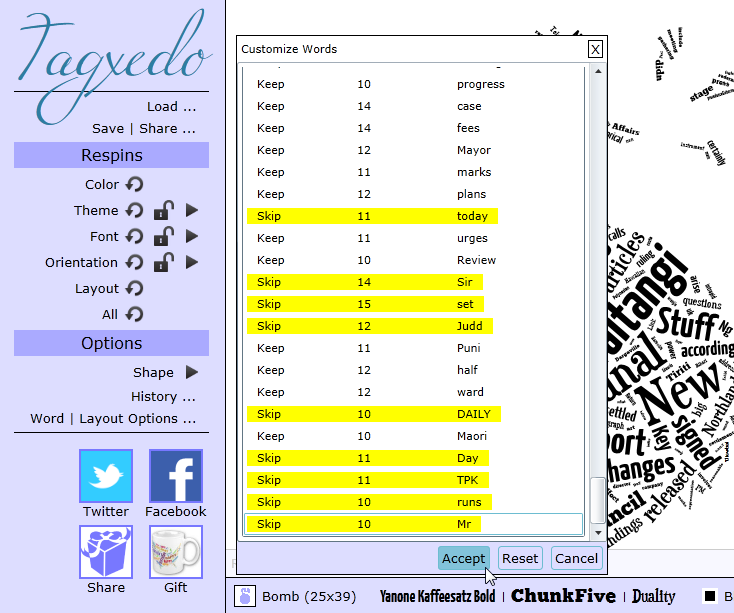Ki te kahore he whakakitenga
ka ngaro te iwi
Without vision or foresight the people will be lost
Thing 20 is Data visualisation tools, which is where I thought that this weeks whakatauki fits in as these tools can provide a visual representation of
- trends over a period of time (giving us foresight and possible directions)
- trends over a geographical region (demographic information) and so on.
1. This is where you start
2. You can now choose where you would like to get your chosen words from, I have chosen (4) News and my chosen words are Maori and Waitangi (to join two words use the tilde symbol ~ between them) and press submit I haven't altered any settings at this stage.
3. From the image below you are able to edit and alter the image as you like. The respins randomly alter the image by the chosen respin (Color, Theme etc) or you can choose all.
4. You can alter the image by using the options, here I have used "Shape" and decided I would use the bomb shape because it looks like a poi.
5. The image is now altered. Go to the Word|Layout options link.
6. This link provides a number of tabs. In the "Word" tab you are able to write (copy and paste) a url to harvest your chosen words. I did a search for Maori and Waitangi on the NZ Herald website then copied the url of the results page.
7. Under the tab "Skip" you are given the list of words within your image and you can skip (hide) these words in your image, after selecting the words to skip click on Accept.

8. You now have your image, mine is a representation of words used by the media in regards to the words Maori and Waitangi
9. If you go to the website when you hover your mouse over
a word it is enlarged and comes forward. (See image below)Tagxedo has been used in real life situations by lskudder."Thing 21" is about tracking and analytics and the exercise is an analysis of the data from this blog.
To date the most popular post was from my post Consommé and the reason is possibly the comment from Steve and a number of tweets about the post. There was a peak on the 5th November in the viewer stats for the month.
 |
| "Kumara" by Sarah Licenced under CC BY-NC-SA 2.0 |
I have looked at my Moodle statistics and found that All logs shows my usage statistics.
The graph shows me in a concise way my usage, which comes from the data in the table underneath.
The graph shows that in the first half of the programme I logged in on Mondays, however after the 10th October I started to log in during the middle of the week and then again on the Friday.
The Outline report shows which links within the Moodle site you have looked at, how many times and when.
Although I can see that both of these sets of information can be useful for students.
- as a way of gauging their progress in a course
- revision of parts of the course where there is one or no views
- their usage patterns and possible reasons for this so that they can use this for planning of study etc
I am going to make a sweeping generalisation by saying that I don't think many students would actually use the data unless it was a compulsory part of the course.
I do think the data is extremely useful for the people teaching courses as it can be used to
- show the parts of a course in Moodle that students are engaging with most
- the parts where students are not engaging at all
- indicate the parts of a course which need redesign because they are either too easy or too difficult.
- show the behaviour patterns of the students both active and passive within a course








